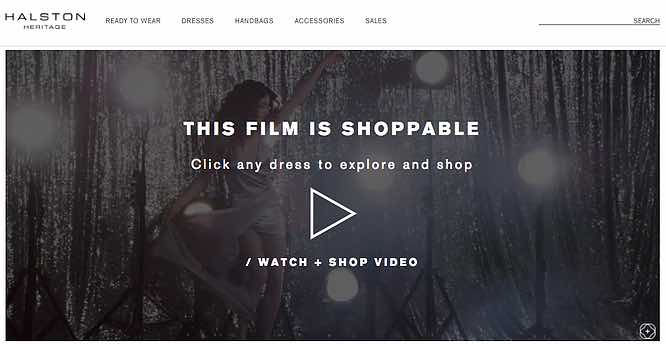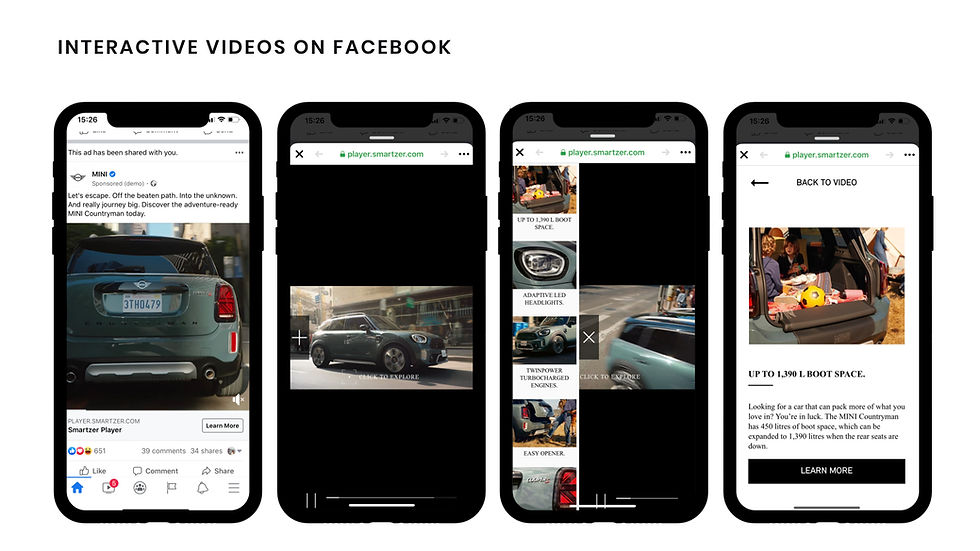Using video for e-commerce can boost your business to new heights. Attention grabbing virtual content encourages increased engagement, higher dwell times on sites and a rise in conversion rates.
Interactive Video e-commerce and the Purchase Funnel

Widely known in marketing strategy, the purchase funnel is a consumer focussed model featuring four stages of awareness, discovery, consideration and conversion.
In the awareness stage the customer’s attention is initially grabbed by creative, captivating and clickable video ads. For example, shoppable video or customisable video. They can then enter the discovery phase by clicking the interactive hotspots to learn more about the products shown. The viewer may be shown pricing details, images, descriptions and even a call to action. They might view a carousel alongside the video that shows other items being featured. The viewer indicates consideration of the product by clicking a call to action button such as “Buy Now” or “Learn More” to be taken to the product page. A conversion will occur when the viewer places an order, books an appointment or downloads a document.
Brands now utilise conversational commerce, video e-commerce and live shopping to provide a new and memorable shopping experience for the customer increasing the likelihood of conversion.
3 innovative technologies that are revolutionising ecommerce:
1. Conversational commerce is the practice of using social interaction to sell products or services. Virtual shopping app, Hero, harnesses conversational commerce to connect brands with customers via text, chat and video. This gives a human feel to computer-driven bots as teams can chat, schedule store visits and interact with shoppers via 1 on 1 video calls. When buying online, customers are considerably less likely to make a purchase than they are in physical stores. This is due to the lack of in person assistants to provide the answers and advice that gives customers the confidence to buy. Through virtual consultations, personalised advice and recommendations, the benefits of in person shopping are brought to the customer’s fingertips online. With the chatbot market set to be worth over $1.34 billion by 2024, conversational commerce is the future for developing customer-brand relationships.
2. Smartzer makes videos shoppable for e-commerce sites. Brands can use their quick and easy tagging platform to easily add an interactive overlay to all their content making it shoppable across their e-commerce site, livestream, social media, and video ads in minutes. When watching a video the customer can click items to instantly see more details about the featured product and add it directly to their shopping cart without leaving the video. By using Smartzer’s shoppable video technology, brands saw a 50% increase in engagement rates and were able to quadruple their conversion rates.

3. Live shopping bridges the gap between offline and online. Bambuser offers an add-on that enables brands to embed a code in their ecommerce sites to stream live through the Bambuser app. Using the app, brands upload the URL’s of the products that they plan to showcase in the live stream then go live to broadcast content to potential customers. If a customer sees an item that they want to buy, they can click the image shown in the side-bar and add it to their basket without leaving the stream. Bambuser also offers a one-to-one live shopping experience so customer service agents can interact individually with customers for tailor made experiences with product display, product comparison, add-to-cart and CRM APIs.
These three innovative and shoppable video technologies are transforming e-commerce helping to build customer trust and bring the offline online.
- Feb 11, 2021
The average consumer scrolls through 300 feet of social media content a day. So, if 90 meters of content is being observed daily, brands need to stand out against the masses to turn views into conversions. The answer could lie within shoppable video.
But what is shoppable video?
Shoppable videos are the future for video content marketing. Captivating visuals and overlaying product tags create an immersive, interactive video experience that will direct the consumer straight to the product on their screen without changing windows. Through this content marketing technology, a consumer was four times more likely to purchase the product shown in the ad. This technology is harnessed by Smartzer to get brands noticed and overcome issues faced in an ever changing technological minefield.
What are the online issues faced by brands?
Pressure to provide an advanced digital shopping experience. With sales from retail at an all time low, the main way for most brands to sell is through ecommerce. As a result, it is essential to provide an unforgettable, first class shopping experience for customers.
Distractions and disconnect. When customers see an ad for a product on social media there will be distractions preventing them from committing to the purchase. This might be from unrelated pop-up ads, redirection to another window or a viewer may arrive at the brands website but the product is nowhere to be seen. These standalone video ads are disconnected from the purchasing process and provide no clear analytics to understand the effectiveness of the content.
Complex online navigation. With the Nations screen time through the roof, finding products featured in the various pieces of content can often entail over a dozen clicks, resulting in a huge missed opportunity where most customers will simply never complete this process.
Limited insights into content performance. Video advertising may be one of the most difficult channels to measure. This is largely because ROI is very limited to high level metrics such as views and dwell time on the video. It is nearly impossible to associate revenue with a video on a brand’s e-commerce site.
The solution?
Shoppable video. The interactive aspect provides a memorable experience that educates and engages a customer. The customer is directed straight to the tagged product with no distractions making them more likely to commit to purchase. The clicks and conversions generated through interactive video are easily measured enabling brands to see clear results.
Updated: Feb 15, 2021

With 93% of marketers using video and businesses publishing on average 18 videos each month, video has never had a bigger focus in marketing strategies. There is also a fast-growing trend of making videos interactive and shoppable by adding clickable hotspots to videos.
“Tech giants and social media companies have been heavily investing in making their platforms more shopping-friendly. Last year, Amazon launched Amazon Live, where hosts talk about and demonstrate products sold on Amazon. Google’s R&D launched Shoploop, and Facebook has made shopping more prominent on Facebook proper, WhatsApp and Instagram.” CNBC
When a viewer is watching the interactive video they can click on the hotspots to instantly see more information and to shop. This provides the viewer with a fun way to engage with video and easily access more information. It also helps brands to convert more customers and access interaction data to better understand video performance.
1. Sharing the interactive videos on an ecommerce site
Including interactive and shoppable videos on an ecommerce website is a highly effective way of making your website stand out. Video commerce enables customers to instantly discover items from videos, which helps with site navigation as well as increasing overall engagement and sales. Especially on mobile devices where navigation across various product and category pages can be difficult, it is crucial to make product discovery and shopping as easy as possible.
If the interactive video features shoppable products, the video can be seamlessly connected with the ecommerce website shopping cart allowing for a single click checkout process.
2. Sharing interactive videos through email newsletter / CRM
Interactive videos can be used to amplify client communication via email newsletters and other CRM tools. Interactive and shoppable video experiences can be launched directly from a newsletter, creating a more immersive experience for customers. The interactive videos also help drive users to more specific pages on your website, which in turn can increase conversion rates by sending more qualified traffic. Including interactive videos in newsletters is very simple and adds a new depth to this content marketing strategy.
This format can also be used to share exclusive content in interactive video format to a select group of customers.
3. Sharing interactive videos via social media

Photo: Smartzer & MINI Interactive Facebook & Instagram Campaign
Social media channels have been at the forefront of providing shoppable formats. Instagram began using shoppable images before introducing live shopping formats, tuning into TV shopping channels like QVC HSN.
In addition to using the platform's native tools, brands can also share external interactive video experiences through stories, posts, and ads. This is particularly helpful for advertisers and influencers who don’t have their own product catalogues and promote products from multiple other brands and retailers.

